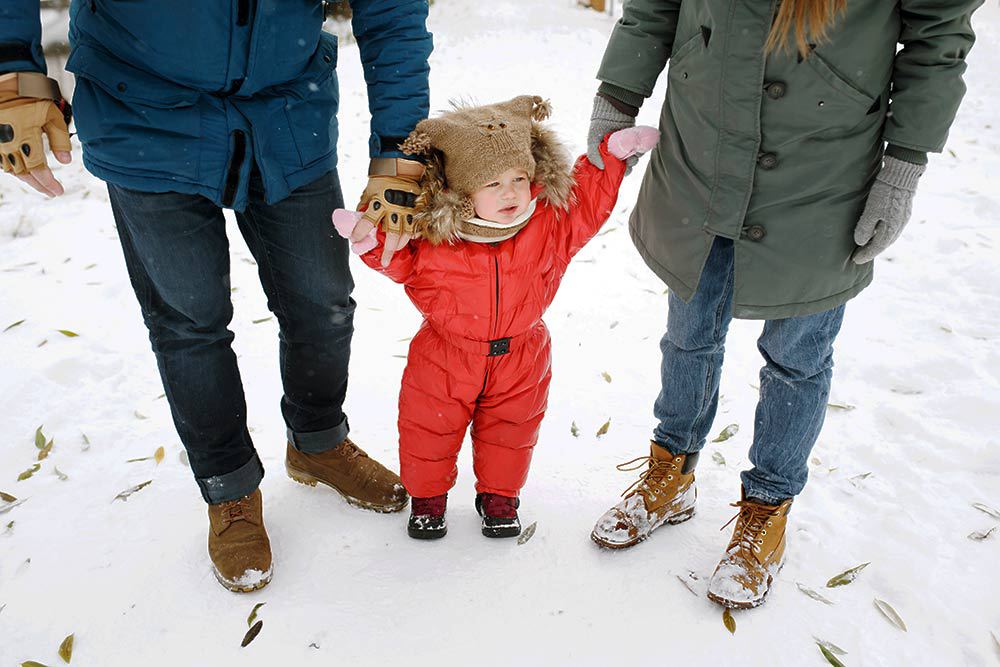How to Know if Your Child Has Frostbite

Signs to look for, what to do, and when to worry.
Medical Experts: Mona Amin, DO; Whitney Casares, MD, MPH, FAAP
For families who live where the winter months are cold—like, really cold—it can be difficult to weigh the benefits of your kids getting outdoor playtime with the risks that come along with frigid temperatures. While chattering teeth and shivers can be quickly remedied with some blankets, heat, and hot cocoa, kids playing outside in colder weather comes with the potential of frostbite.
What is Frostbite and How Does it Happen?
When you think of frostbite, the first thing that probably comes to mind is an image of severe frostbite (the kind where a limb is completely black and at risk of amputation). According to Stanford Medicine, “Frostbite is damage to parts of the body from freezing. It occurs when ice crystals form in the skin or deeper tissue … Frostbite can cause serious injury and needs attention right away. It can cause long-lasting (permanent) tissue damage.”
While this kind of frostbite is certainly real, it’s unlikely that an appropriately dressed child will come inside with this level of frostbite after playing in the snow for an hour. Instead, they may show signs of frostnip or mild frostbite, which will not cause permanent tissue damage and is usually safe to treat at home.
Children experience frostbite or frostnip after prolonged exposure to cold temperatures—typically below freezing (32 degrees Fahrenheit). Frostbite and frostnip are most commonly found on the nose, ears, fingers, toes, cheeks, and chin.
It’s important to remember that while the air temperature is certainly a factor to consider, a cold, cloudy day is not the only condition in which a child can develop frostbite. Parents should also be aware of the windchill outside and how damp the air is. In fact, simply putting ice directly on the skin for too long can cause frostbite.
“Wet skin is also more likely to develop frostbite faster than dry skin, so be sure to dry your child’s hair and skin before heading [outside]” says pediatrician Whitney Casares, MD, MPH, founder of The Modern Mamas Club App. She also advises caregivers to quickly change their children into something dry if they notice their clothes getting wet while they’re playing outdoors.
In general, children are more likely to develop frostbite than adults because they lose heat from their skin faster. Other risk factors include:
- Having reduced blood flow from conditions such as diabetes
- Having reduced blood flow due to gloves, boots, socks, or other clothing items that are too tight
- Not wearing appropriate (warm) clothing for the conditions
- Being in cold, windy weather, which can cool the skin more rapidly
All of this being said, it’s still incredibly important for kids to get outside and play as much as they possibly can.
“Outside play is essential for children,” says pediatrician Mona Amin, DO, founder of Peds Doc Talk and medical advisor for Bug Bite Thing, adding “[but] it is important to consider the weather conditions” to ensure your child’s safety when it comes to frostbite.
Taking the proper precautions to avoid frostbite is key, but even then frostbite or frostnip can still happen. In this case, caregivers need to know what to look for and what to do if their little one comes inside with signs of frostbite.
What are the Signs of Frostbite in Kids?
The good news about frostbite is that it happens slowly, so as long as you’re keeping an eye on your child as they play outside, you’re likely to catch signs early (making it much more probable that you can treat symptoms at home).
“Frostbite is progressive, meaning the longer a child is exposed to cold temperatures, the more apparent signs will be,” explains Dr. Amin. “Initially, you may notice frostnip, in which the affected skin will be red and swollen with mild discomfort,” she says. And Dr. Casares says, in cases of frostnip, the skin may also be “cold, painful, or tingling.”
If frostnip isn’t caught and the child continues to be exposed to cold temperatures, Dr. Casares says more severe frostbite will appear as “hard, white, numb skin.” The skin could also appear very red, according to Dr. Amin, and if it’s not numb then it may present with a “burning sensation.” If it becomes severe, it may present as “gray, white, or waxy and form blisters,” Dr. Amin adds.
How to Prevent Frostbite in Kids
Ideally, you won’t have to worry about frostbite at all because, thankfully, there are measures caregivers can take to avoid the situation.
“Make sure you dress your child appropriately for extreme, cold weather,” urges Dr. Casares, “including layering on waterproof gloves, hat, scarves, jackets, and face covering if needed.” (Consider investing in a bunting bag for your stroller if you live somewhere walkable but cold.)
Dr. Amin notes that appropriate layers should be made of loose-fitting warm clothing. She also stresses that caregivers “remember that children are eager to play and may not express themselves when they’re feeling cold.” Because of this, she recommends parents regularly stop playtime to do a quick check for frostbite in common areas like the face, fingers, and toes, similarly to how you would periodically check to ensure a child is not getting a sunburn while outside during the summer.
Additionally, Dr. Amin reiterates how important it is for little ones to get outdoor play time as much as possible, so she suggests parents ensure their children take frequent breaks to warm up inside on a cold day. “Shorter outside time is a safe option to get outdoors still and play,” she explains.
Finally, caregivers should always use common sense and be mindful of outdoor conditions before sending their child outside to play. Always consider the air temperature, windchill, whether or not it’s damp outside, if the sun is out, and your child’s general health before sending them outdoors. In some cases, it is safer to opt for a day of indoor play. If it’s uncomfortably or unbearably cold for you, then it’s probably best to stay indoors.
What To Do if Your Child Has Frostbite
Mild frostbite or frostnip can typically be treated at home. If your child is playing outside and you start to notice signs of frostbite, then here are some things Dr. Amin and Dr. Casares say you can do to help:
- Immediately bring your child inside.
- Remove all wet clothing and change them into warm, dry clothes.
- Warm the frostbitten skin in warm (not hot) water for 20 to 30 minutes. This can be done by applying a warm washcloth or soaking the affected area directly in the water.
- Do not rapidly warm, use direct heat, or rub the frostbite, as this can cause more pain and tissue damage.
- After warming the skin, use clean cloths or bandages to loosely wrap the warmed areas to help prevent refreezing.
- If your child is experiencing discomfort, offer acetaminophen (for children under 6 months of age) or ibuprofen (for children 6 months and older).
If your child’s skin doesn’t appear to be getting better or if you notice more severe signs of frostbite, call the pediatrician right away, as more intervention may be necessary to fully treat the condition.
Frostbite can seem really scary, but keep in mind that most of us made it through many, many snow days outside as kids without any frostbite. As long as you practice general cold weather safety and you keep an eye on your little one’s toes, fingers, nose, and cheeks on chillier days, you will all be just fine. Now, go build a snowman and enjoy the brisk air with your kiddo while you can.








